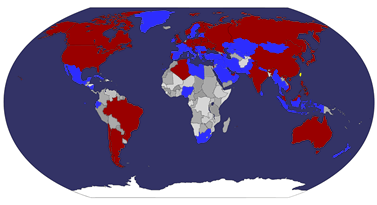 7 (R):Rifles (SVT-40) and (AVS-36).
7 (R):Rifles (SVT-40) and (AVS-36).8 (R):Revolver 1895, gun (TT) 1933.
9 (R):Submachine guns (PPS-43) and (PPSH-41).
10 (R):Machine guns (DP) and (SG-43).
 7 (R):Rifles (SVT-40) and (AVS-36).
7 (R):Rifles (SVT-40) and (AVS-36).








 "The CHINA 2009 World Stamp Exhibition will be held in Luoyang City, Henan Province, from April 10 to 16. CHINA 2009, presented in commemoration of the 60th anniversary of the founding of the People's Republic of China, aims to foster closer ties and co-operation among philatelists and stamp collectors worldwide, and promote philately as a universally enjoyable hobby. The event also offers Hongkong Post an excellent chance to showcase quality stamps from Hong Kong to stamp lovers on the Mainland and around the globe."-Hong Kong Post
"The CHINA 2009 World Stamp Exhibition will be held in Luoyang City, Henan Province, from April 10 to 16. CHINA 2009, presented in commemoration of the 60th anniversary of the founding of the People's Republic of China, aims to foster closer ties and co-operation among philatelists and stamp collectors worldwide, and promote philately as a universally enjoyable hobby. The event also offers Hongkong Post an excellent chance to showcase quality stamps from Hong Kong to stamp lovers on the Mainland and around the globe."-Hong Kong Post







Hasior was an active participant of the artistic life of Zakopane, paying particular attention to the activities of his gallery, which was established in 1985 as a branch of the Tatra Museum. That museum was also the beneficiary of Hasior's last will, and received his works after the artist's death. Many of Hasior's other creations are kept by state museums in various Polish towns and cities and in national galleries worldwide, including Stockholm, Oslo, Paris, Rome, Milan, Montevideo and Sao Paulo, not to mention those in the hands of the private collectors.
The work
Władysław Hasior was an outstandingly original artist who never copied any trends. In his work he utilised various kinds of material, including some finished objects (such as dolls, pitchforks, mirrors) and fragments of others. That was because he claimed that the traditional sculptor's medium is not capable of conveying the message he wanted to send. He used to say "I'm using materials which have some meaning. Each and every object has its sense, and if you put them together, you get an aphorism. [...] I believe the artist's work consists in provocation, both in the intellectual and the creative aspect."
In his outdoor creations the artist utilised fire, water, wind, sound and glass. One of his original creative inventions was using holes made in the ground in order to cast cement figures. Critics saw the influences of Dadaism, surrealism and pop art in Hasior's work. He was also inspired by folk arts, and was a careful observer of everyday reality, in particular that of the countryside. The artist liked to watch and document the cheap aesthetics of something he called "county arts"(sztuka powiatowa), which he then referred to in his work. He also reached into the mythology and conjured up memories of the war, invariably presenting the subjects in an unconventional manner and attaching new meaning to trite symbols, mixing macabre and cruelty with grotesque, irony and jest. His exhibitions were full of controversy, but at the same time prompted the viewers to reflection.
Banners
Hasior's assemblages, inspired by religious procession banners, started to appear in the mid 1960s. Although they were constructed with the use of fabric, plastic objects, wood, metal or glass, the artist called them "paintings." They are very large, reaching between 1,5 and 4 metres in height and around 1 metre in width, and they are a mixture of both solemn symbols and the everyday aspects of life, which is seen from their titles such as: The Banner of St. Pensioner (Sztandar Św. Emeryta), The Banner of the Bird Spider (Sztandar Ptasznika), The Banner of Mona Lisa (Sztandar Mony Lisy), The Banner of Poland (Sztandar Polski), The Banner of the Black Angel (Sztandar Czarnego Anioła), The Flinging Blaze Banner (Sztandar Blaskomiotny), The Banner of Ecstasy (Sztandar Ekstazy). The artist used those banners in his outdoor performances such as the procession called The Feast of the Blooming Apple Tree (Święto Kwitnącej Jabłoni) in Łąck.


 taiwan
taiwan  cover or postcard
cover or postcard  FDC
FDC 





























































































